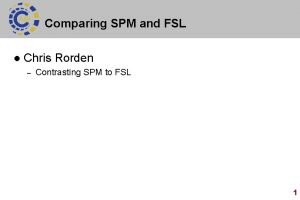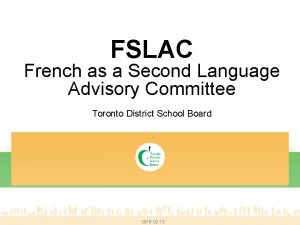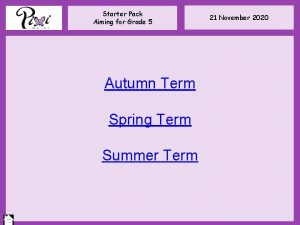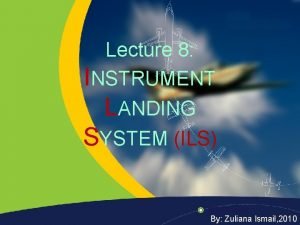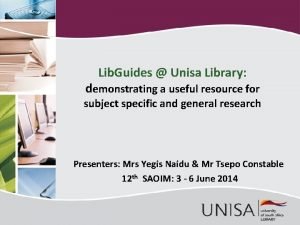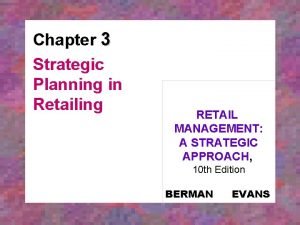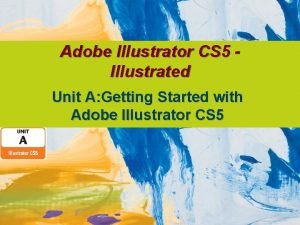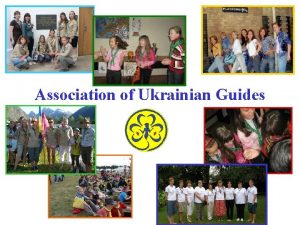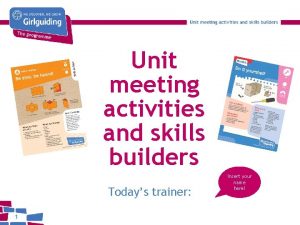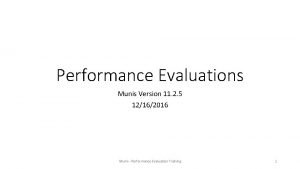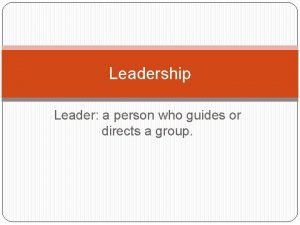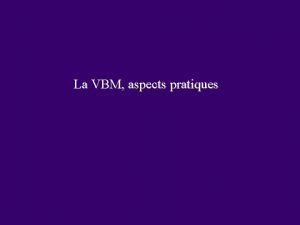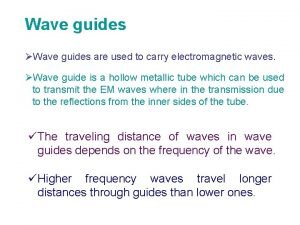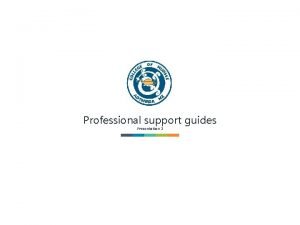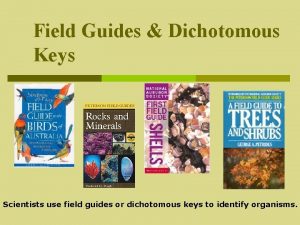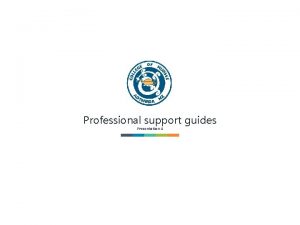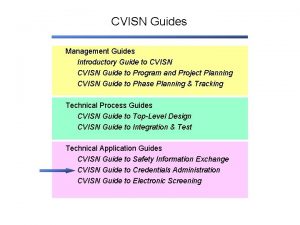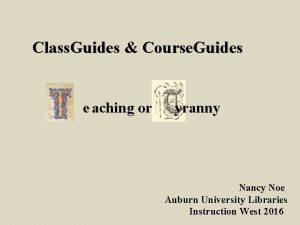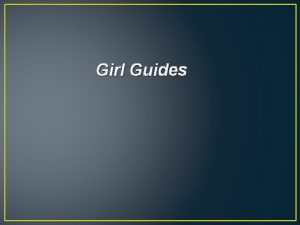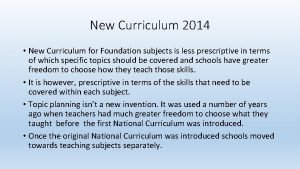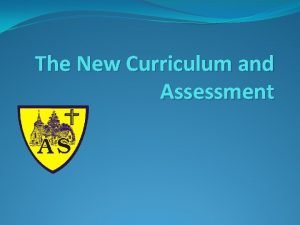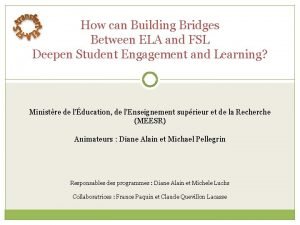AIMing for the New FSL Curriculum Guides to






















































- Slides: 54

AIMing for the New FSL Curriculum Guides to Reflective Practice for Core French Teachers CEFR by Kimberly Peters and Juliet Young Durham District School Board peters_kimberly@ durham. edu. on. ca New FSL Curriculum young_juliet@ durham. edu. on. ca

MYTH: AIM no longer meets a lot of the expectations of the new FSL curriculum. FACT: AIM integrates seamlessly with the new curriculum, even more so now than with the old curriculum!

AIM INTEGRATION WITH NEW FSL CURRICULUM • students listening to teacher speaking French entire class through support of TLSE (gesturing of sentences) • interactive listening strategies regularly being used during IPG (independentpartner group work) • variety of texts (story retell, invitations to performances, student profiles, menus) • ample opportunity for creative writing (story retell and story extension, rap/rhyme, journal) • grammar raps to target common errors • various writing stages – from peer review to publishing LISTENING to understand to interact SPEAKING to communicate and to interact WRITING READING comprehension • many opportunities for guided spoken interaction (gestures) and spontaneous spoken interaction (IPG) • all classroom talk is exclusively in French • role-playing helps to lower students’ inhibitions about speaking in another language (“affective filter”) • practising/memorizing lines improves pronunciation, intonation, expression, confidence • TLSE used to fix grammar errors while speaking • in junior grades, reading skills are developed AFTER language has been introduced orally (pronunciation) • various reading strategies (decoding, questioning, cognates, word families, posters) • balanced literacy approach -- “La LECTURE en Action” (before/during/after reading strategies)

KEY ELEMENTS OF AIM (Accelerative Integrated Method) E) Transfer to spontaneous speech and creative storytelling D) Language Manipulation Activities (written and oral) C) Stories/Plays/Music/Dance B) Pared Down Language (PDL) A) The Gesture Approach Seulement en français!

MYTH: AIM doesn’t offer any opportunities for covering the cultural expectations in the new curriculum. FACT #1: AIM has readers and cultural literacy packs that offer numerous opportunities to cover cultural expectations.

AIM CULTURAL RESOURCES (GR 4 - 6) Grade Geographical area AIM Resource 4 Ontario Culture Literacy Pack 1 A: « Mathieu et Cassandra, deux francophones en Ontario » Introduces students to Franco-Ontarian culture by following the pen-pal conversation of two students (one in Sudbury and one in Ontario). 5 Quebec Culture Literacy Pack 2 A : « Ti-Jean, le violoneux » Introduces students to Quebecois cultural traditions (including cuisine and music). It features two readers (Ti-Jean, le violoneux based on the famous Quebec folk hero, and “Mon livre de recettes”, a collection of traditional Quebec recipes). 6 eastern, western, and northern Canada “L’aventure de Stephanie” Reader and Activity Book About an 11 -year-old girl who lives in northern Qebec and attends a “Festival du Voyageur”, but after becoming bored of the festivities wanders away and finds herself taken away on a scary adventure, but gets saved and fins herself more appreciative of the festivities. Great springboard for introducing students to the Festival du Voyageur that takes place in St. Boniface in Winnipeg, Manitoba.

AIM CULTURAL RESOURCES (GR 7 - 8) Grade Geographical area AIM Resource 7 Americas outside Canada (e. g. , Louisiana, Haiti, Guadeloupe, St. Martin, St. Lucia) AIM Reader (Level 1): “Jean-Michel – Acrobate”, a story about a boy who lives in slums of Cap-Haïtien in Haiti. He uses his acrobatic skills to earn money with which he buys his mom a birthday present. AIM Reader (Level 2): « Je m’appelle Christian: Ma vie et mon art » , a story about a young man who spent most of his life in an orphanage in Haiti. In story, we learn cultural and physical aspects of Haiti. AIM Reader (Level 2): “En vacances!”, a story about two teenagers are on trip from home in Montreal to Martinique during their holiday. In story, we learn about culture of Martinique. 8 Europe AIM Reader (Level 2): Un beau jour”, a story about two teenagers met during trip to Martinique. Now they travel through Europe. They meet in Paris. In story, we learn about France and its cultural aspects.

FACT #2: Culture can also be injected through authentic documents that provide students with opportunities to use language spontaneously.

Source: journaldemontreal. com - choose "Le Sac de Chips" for current articles

MYTH: The AIM program is pretty much about teaching students to memorize a play. It doesn’t really follow the best practices of Core French teaching. FACT: AIM has always (and continues to) support the best practices of Core French teaching. For example, take a look at the various Guides to Reflective Practices for Core French Teachers.

HOW AIM ALREADY SUPPORTS BEST PRACTICES IN “MODULE 1: ORAL PROFICIENCY” “Maximizing exposure to French” • done through Gesture Approach/TLSE • French spoken during entire class “Instilling confidence” • multiple intelligences approach of AIM addresses all learners • vocalizing praise of student during TLSE • scaffolded approach of AIM builds on prior knowledge • early success = confidence! ***Note: “AIM forum” (old AIM Language Learning portal) is the first reference in the “Suggestions for Further Reading” section at the end of the document. ***

https: //www. pinterest. com/ pin/163185186474980776 /

HOW AIM ALREADY SUPPORTS BEST PRACTICES IN “MODULE 1: ORAL PROFICIENCY” “Error correction” • done through TLSE (gestures, total questions) “Learning by listening. . . and speaking” • teacher dramatizing/gesturing play before students see script • singing! • TLSE/IPG provide ample opportunities for students to listen to and speak in French

HOW AIM ALREADY SUPPORTS BEST PRACTICES IN “MODULE 2: POSITIVE LEARNING ENVIRONMENT” “Establishing a positive tone” • Gesture Approach lends itself to a positive, fun tone and atmosphere in the room (e. g. , rap d’entrée) • AIM teachers are often passionate, energetic. . . this energy naturally rubs off on students • students help their peers to speak French (e. g. , if they hear peer speaking in English) • pleasant repetition makes students feel safe and confident “Building community” • inviting parents, school to attend plays (e. g. , assembly) “Establish classroom norms and routines” • daily/leaving routines (e. g. , rap d'entrée) • cards/points/etc. for speaking in French

HOW AIM ALREADY SUPPORTS BEST PRACTICES IN “MODULE 3: THE ACTION-ORIENTED APPROACH” “Introducing students to action-oriented tasks” • Many opportunities to develop action-oriented tasks through plays by identifying and analyzing themes, and using those as "jumping off" points • Numerous tasks in “AIM Action-Oriented Tasks Resource Book, inspired by CEFR”, e. g. : • telling a friend what you learned from a conversation with a new student at school • you are applying to a French sports club and are required to have an interview in French

Scaffolding Learning in an Action-Oriented Approach At the introductory level, students frequently are asked to memorize oral presentations and scripted dialogues. It is essential to provide opportunities for them to begin to interact with the teacher and each other to complete tasks that reflect or simulate real-life situations that are unscripted and sometimes unpredictable. It is important to note that adopting an action-oriented approach does not mean abandoning presentations and dialogues that have been a part of the communicative approach. These activities are a critical part of the scaffolding and practice that is necessary to enable students to acquire new vocabulary and facility with the language. Curriculum Services Canada - A Guide to Reflective Practices for Core French Teachers, Module 3: The Action-Oriented Approach, p. 6 https: //csc. immix. ca/files/30/1370607618/FSL-module-3. pdf

HOW AIM ALREADY SUPPORTS BEST PRACTICES IN “MODULE 4: COOPERATIVE LEARNING” “Working in groups” • IPG (Independent-Partner Group Work) is an integral part of AIM program • students are able to work in various small groups to build on oral fluency while working (e. g. , cahiers, story retell/extension, culminating tasks, etc. )

MYTH: The AIM program is simply about teaching plays. When are students ever going to need to talk about pigs in real life? ? ? FACT: The plays are based on high-frequency vocabulary which, once internalized, can be applied in numerous situations. There also many opportunities to develop relevant, authentic, action-oriented tasks based on each AIM play/reader.

ACTION-ORIENTED TASKS An action-oriented task follows specific criteria: ü Learners are social agents who use the target language in order to carry out a pre-defined task with tangible results ü Oral communication is spontaneous, purposeful, and set in the context of everyday life ü The goals of the task are clearly identified and use verbs of action, (e. g. , give, make, explain, persuade, etc. ) ü The task requires a problem to be solved, an objective to be achieved, or a goal to be accomplished, subject to certain parameters and constraints ü Authentic texts, language competencies, and learning strategies are integral to accomplishing the task (Collins & Hunter, 2013, p. 8)

“BACKWARDS PLANNING” What authentic task do we want students to be able to achieve? How can we connect AIM content to the task? What will students need to be able to do in order to achieve the task?

AIM ACTION-ORIENTED TASKS Comment y aller?

Synopsis: About the misadventures of a girl from Quebec who tries to visit her friend in Paris. In the end, she makes it to his house only to find that he has already left to visit her. Themes: § Modes of transportation (e. g. , car, train, boat) § Landmarks in Quebec and France (e. g. , Château Frontenac, Eiffel Tower) Culminating Task Scenario: AIM Language Learning, la société qui a produit la pièce “Comment y aller? ”, veut ajouter une carte de l’histoire à la fin de la prochaine publication de la pièce. AIM demande à toutes les classes de français dans les écoles de la région de Durham à faire une carte qui montre les événements très importants dans la pièce. AIM va choisir et produire les meilleures cartes. Une carte de l’histoire, Comment y aller?

Curriculum Expectations Assessment Opportunities Listening to Understand Student listens and responds to questions about map during peer review feedback. Speaking to Understand Student explains map to peers during peer review feedback. Reading Comprehension Student demonstrates understanding of main ideas and details of “Comment y aller? ” story in map. Writing: Purpose, Audience, and Form Student applies characteristics of a map as a media text form. Writing: The Writing Process Student creates a plan, outlining the main events of the story; then, drafts and revises a map based on the story. Une carte de l’histoire, Comment y aller?

Pre-tasks as whole-class, unpack learning goal and cocreate success criteria while analyzing student exemplars of maps teach language structures: § mapping vocabulary (e. g. , le titre, les symboles, une légende, une rose de vents, une échelle…) § verbs (marcher, nager, monter, descendre) § modes of transportation (l’auto, le bateau, le train, la soucoupe volante, l’avion) teach characteristics of a map § brainstorm in groups the characteristics of a map using a Frayer’s model, while looking at various maps § find/create worksheets related to mapping Une carte de l’histoire, Comment y aller?

teach landmarks and geography (i. e. , Paris is east of Canada, Quebec is a province of Canada) whole-class modelling and guided practice: § create outline and design map based on familiar story (e. g. , “Les trois petits cochons”) games/activities: § Sept-Débout - using images of modes of transportation or characters from play § Autour du Monde - with vocabulary related to mapping Une carte de l’histoire, Comment y aller?

Student Exemplar Une carte de l’histoire, Comment y aller?

Student Exemplar Une carte de l’histoire, Comment y aller?

Student Exemplar Une carte de l’histoire, Comment y aller?

AIM ACTION-ORIENTED TASKS Boucles Violettes

Synopsis: Boucles Violettes – in this retelling of Goldilocks, a young girl enters the home of The Three Bears, eats their food, breaks their instruments, and runs away screaming when they return. Themes: § Food, hobbies, family, homes Culminating Task Scenario: Tu vas faire partie d’un échange bilingue. Tu veux que ton/ta partenaire soit confortable chez toi quand il/elle arrive, alors tu prépares un album de photo et participes dans une session Skype pour présenter les membres de ta famille. Voici ma famille Boucles Violettes

Pre-tasks teach language structures § les membres de la famille (mère, père, frère, sœur, etc. ) § les passe-temps (chanter, regarder la télévision, etc. ) § les traits de personnalité whole-class modelling and guided practice: § presenting different family members both orally and with an album or other visual resource games/activities § Parle/Échange/Gagne § J’aime un ami… § Trouve quelqu'un qui. . . Voici ma famille Boucles Violettes

use of authentic documents § cultural tie-in opportunities § shared and guided reading § opportunities for spontaneous talk § search for brief news articles about families or family-related info-graphics such as: Image clipped from: http: //naitreetgrandir. com/fr/nouvelles/fic he. aspx? doc=20141008 -portaint-famillequebec-infographie Voici ma famille Boucles Violettes

Curriculum Expectations Assessment Opportunities Listening to Interact Student listens to “exchange partner” and asks appropriate questions for clarification Speaking to Communicate Reading Comprehension Student describes his/her family Writing: The Writing Process Student generates ideas and organizes album appropriately Student reads and demonstrates understanding of various families and/or family-related info-graphics Voici ma famille Boucles Violettes

AIM ACTION-ORIENTED TASKS Le chat et la lune

Synopsis: A cat believes that the moon has fallen in the water. All the other animals also panic until the king shows them that they are simply looking at a reflection. Themes: § animals and parts of the body Culminating Task Scenario: Pendant tu fais du camping dans le parc provincial Algonquin avec ta famille, tu réalises que ton animal domestique est perdu! Tu cherches et cherches, mais tu ne peux pas le trouver. Tu décides de mettre une affiche de ton animal sur un grand arbre dans le parc pour aider à trouver l’animal. Un jour plus tard, une fille téléphone et laisse un message qui dit qu’elle penses qu’elle a trouvé ton animal ! Mais tu réalises qu’elle a trouvé un autre animal. Zut ! Téléphone elle et laisse un message qui explique qu’elle n’a pas trouvé ton animal et comment tu le sais. Mon animal domestique est perdu! Le chat et la lune

Curriculum Expectations Assessment Opportunities Listening to Understand Student listens to recorded voicemail and identifies key characteristics of the found animal. Speaking to Understand Student leaves a voicemail explaining how he/she know it is not his/her pet. Reading: Purpose, Form and Style Writing: Purpose, Audience, and Form Student reads sample poster and identifies key information in the poster (text form). Student applies characteristics of a poster (text form). Writing: The Writing Process Create an outline for the poster, then draft/revise/polish it. Mon animal domestique est perdu! Le chat et la lune

Pre-tasks teach language structures § les parties du corps (e. g. , les pattes, le poil, les yeux, la tête, la queue) § la taille (e. g. , petit(e), grand(e), moyen(ne)…) § l’âge § la personnalité (e. g. , drôle, gentil(le), fou/folle…) § une description (e. g. , aboie/miaule fort, aime courir) teach characteristics of a poster § in groups, use Frayer’s model to brainstorm characteristics of a poster, while analyzing sample “Wanted” posters § worksheets related to animals, body parts, adjectives Mon animal domestique est perdu! Le chat et la lune

whole-class modelling and guided practice: § create Wanted poster using a character (real or imagined) § oral conversation, based on the idea that the example character has been found games/activities § Sept-Débout - using images of body parts or animal characters § “Autour du monde” - with images of body parts § “Qui est-ce? ” – Student sits at front of class and represents animal. Class has to guess which animal by asking questions) § Songs: § Alouette https: //www. youtube. com/watch? v=9 d. N 4 A 0 Tv. MSk § Avec un Gros Nez (Alain Lelait) https: //www. youtube. com/watch? v=Ub. V 1 n 6 zp. QE&list=PL 3775 B 9 A 05 B 55 B 07 E&index=35 Mon animal domestique est perdu! Le chat et la lune

cultural tie-in opportunities § link scenario to grade-level cultural expectations (e. g. , for Gr 4, choose an Ontario Provincial Park in a French-speaking community; for Gr 5, choose a campground in Quebec) shared/guided reading and opportunities for spontaneous talk through authentic documents § Kijiji (chien perdu) § Quebecmeme. net (ALWAYS preview and download in advance) Mon animal domestique est perdu! Le chat et la lune

Mon animal domestique est perdu! Le chat et la lune Source: kijiji. ca

Mon animal domestique est perdu! Le chat et la lune Source: Quebecmeme. net

Student Exemplar Mon animal domestique est perdu! Le chat et la lune

AIM ACTION-ORIENTED TASKS L’arbre ungali or Salut, mon ami!

Synopsis: L’arbre ungali – many animals go on a long journey seeking the name of a magical tree. All but one fall and hit their heads on a rock, forgetting what they went to learn. Salut, mon ami! – a boy who is not athletically inclined repeatedly gets injured while trying to learn basketball to impress a girl Themes: § Risk-taking, respect for self and others, parts of the human body Culminating Task Scenario: Tu fais partie d’un voyage du ski au Québec avec ton école, mais tout ne va pas bien, et tu dois aller à l’hôpital et parler avec le médecin. Après, écris un texto à vos parents et explique ce qui s’est passé. À l’hôpital L’arbre ungali or Salut, mon ami!

Curriculum Expectations Assessment Opportunities Listening to Understand Student listens to medical staff and responds to their directions during “exam”. Speaking to Communicate Reading: With Fluency Writing: Purpose, Audience, and Form Writing: The Writing Process Student explains his/her symptoms and/or the circumstances that led to an injury. Student reads and completes hospital registration form. Student creates a text message for his/her parents explaining what has transpired and containing all relevant details. À l’hôpital L’arbre ungali or Salut, mon ami!

Pre-tasks teach language structures § les parties du corps humain (e. g. , les jambes, le dos, la tête) § l’information personnel (le nom, la date de naissance, l’adresse) § les symptômes (la douleur, le sang, une toux, etc. ) § le vocabulaire médical (le médecin, l’infirmière, etc. ) whole-class modelling and guided practice: § Oral conversation, based on the idea that you are sick or injured § Written text (registration form) games/activities § Parle/Échange/Gagne § Madame Dit À l’hôpital L’arbre ungali or Salut, mon ami!

AIM ACTION-ORIENTED TASKS Le garçon qui joue des tours

Synopsis: Deals with sibling rivalry and appropriate behavior toward others. A boy who constantly enjoys playing tricks on others at their expense learns an important lesson about kindness. Themes: § Kindness Culminating Task Scenario: Near the end of the school year, you overhear a group of Gr 6 students grumbling that they don’t want to learn the “Le garçon qui joue des tours” play next year because they think it will be boring without animal characters. You and your friends decide to put together a trailer in an effort to persuade them that it’s actually a really funny and interesting story, even without animals as characters. You also decide on using a trailer as the media form because you don’t want to give away the ending. After you create the trailer, you place a copy of the DVD on the desk of the Gr 6 French teacher, along with a note describing the content on the DVD and requesting that the teacher plays it for the Gr 6 classes. Bande-annonce Le garçon qui joue des tours

Possible Extensions: § Play trailers for Gr 6 class. § To cover Listening to Understand expectations, Gr 6 students can respond to oral text by identifying key information in trailer. § To cover Speaking to Understand expectations, Gr 6 students can also provide oral peer review feedback of trailers. § Have class vote on best trailer. Then: § enter it into a student media festival (e. g. , DDSB’s Captivate Media Festival) § show it at Character Trait Assembly (e. g. , Kindness) § screen it at school’s film club Bande-annonce Le garçon qui joue des tours

Curriculum Expectations Assessment Opportunities Listening to Understand Student listens to peer’s feedback of his/her trailer and identifies what peer liked and/or needed to be improved. Speaking to Understand In trailer, student’s ability to speak with fluency (e. g. , pauses, expression). Student’s contribution of ideas to group’s To-Do list during the planning of trailer. Reading Comprehension Student’s demonstration of understanding of story, “Le garçon qui joue des tours”. Reading: Purpose, Form and Style Student’s demonstration of understanding of trailer as media text form. Writing: Purpose, Audience, and Form -Storyboard (individual) -Trailer (group) -To-Do list (group) -Note to teacher (individual) Bande-annonce Le garçon qui joue des tours

Pre-tasks teach characteristics of film trailer : § cooperative group brainstorming of characteristics using Frayer’s model § three-act structure of a trailer (introduction, problem, climax) § identify characteristics in released French film trailers (e. g. , Gravity, Lord of the Rings, etc. ) § storyboard whole-class and guided practice: § three-act structure (e. g. , “SImon’s Cat”) § storyboard § To-Do list for planning of trailer (e. g. , props, filming equipment, assigned roles) § note-writing Bande-annonce Le garçon qui joue des tours

games/activities to reinforce vocab related to film trailers § Mini-whiteboards § Word wall § Cours au tableau et écris! § Autour du monde Bande-annonce Le garçon qui joue des tours

Student Exemplar 2 -min film trailer produced by a group of three Gr 8 students Bande-annonce Le garçon qui joue des tours

C'EST À VOUS! What great ideas do YOU have for linking AIM plays to action-oriented tasks? Brainstorm with a few others, and add your ideas to our live, interactive chart! Access the chart from: http: //bit. ly/1 FG 6 g 8 i OR QR code:
 Runstop r19
Runstop r19 Fsl vs spm
Fsl vs spm Fsl roi analysis
Fsl roi analysis Fsl fmri
Fsl fmri Tdsb fsl
Tdsb fsl Air direction indicator
Air direction indicator Pixi maths aiming for grade 5
Pixi maths aiming for grade 5 Wind sock
Wind sock Ils localizer antenna
Ils localizer antenna Right touching digital marketing
Right touching digital marketing Aiming high for disabled children
Aiming high for disabled children Define anticipation guide
Define anticipation guide Act 2 othello summary
Act 2 othello summary Unisa library guide
Unisa library guide Cssd design guidelines
Cssd design guidelines Strategic retail planning
Strategic retail planning Adobe illustrator smart guides
Adobe illustrator smart guides Integral valve guide
Integral valve guide Association of ukrainian guides
Association of ukrainian guides Unit meeting
Unit meeting What is the blue section of the erg
What is the blue section of the erg Kde munis guides
Kde munis guides Cub bulbul promise
Cub bulbul promise Whose voice guides your choice
Whose voice guides your choice Wwc practice guides
Wwc practice guides God guides me
God guides me The person who guides
The person who guides Kontinuitetshantering
Kontinuitetshantering Novell typiska drag
Novell typiska drag Tack för att ni lyssnade bild
Tack för att ni lyssnade bild Ekologiskt fotavtryck
Ekologiskt fotavtryck Shingelfrisyren
Shingelfrisyren En lathund för arbete med kontinuitetshantering
En lathund för arbete med kontinuitetshantering Personalliggare bygg undantag
Personalliggare bygg undantag Tidbok för yrkesförare
Tidbok för yrkesförare Anatomi organ reproduksi
Anatomi organ reproduksi Förklara densitet för barn
Förklara densitet för barn Datorkunskap för nybörjare
Datorkunskap för nybörjare Tack för att ni lyssnade bild
Tack för att ni lyssnade bild Mall debattartikel
Mall debattartikel Magnetsjukhus
Magnetsjukhus Nyckelkompetenser för livslångt lärande
Nyckelkompetenser för livslångt lärande Påbyggnader för flakfordon
Påbyggnader för flakfordon Formel för lufttryck
Formel för lufttryck Svenskt ramverk för digital samverkan
Svenskt ramverk för digital samverkan I gullregnens månad
I gullregnens månad Presentera för publik crossboss
Presentera för publik crossboss Argument för teckenspråk som minoritetsspråk
Argument för teckenspråk som minoritetsspråk Vem räknas som jude
Vem räknas som jude Klassificeringsstruktur för kommunala verksamheter
Klassificeringsstruktur för kommunala verksamheter Epiteltyper
Epiteltyper Claes martinsson
Claes martinsson Centrum för kunskap och säkerhet
Centrum för kunskap och säkerhet Byggprocessen steg för steg
Byggprocessen steg för steg Bra mat för unga idrottare
Bra mat för unga idrottare

